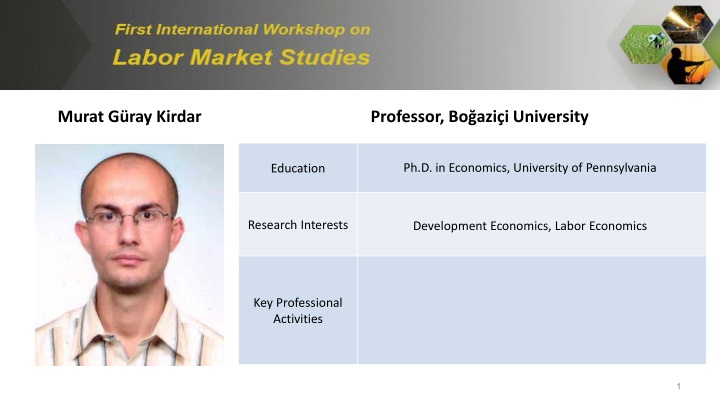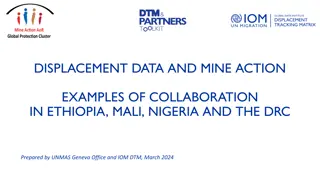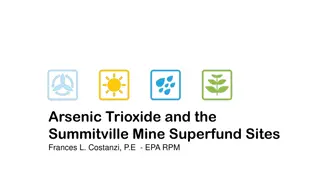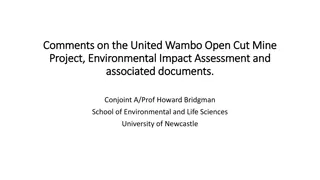
Murat G. Kirdar - Research on Returns to Schooling and Education Policy
Explore Murat G. Kirdar's research on estimating the effect of education on earnings in Egypt, focusing on the impact of the 1988 education reform. Discover key findings and distinguishing features of the study regarding returns to schooling in developing country contexts.
Download Presentation

Please find below an Image/Link to download the presentation.
The content on the website is provided AS IS for your information and personal use only. It may not be sold, licensed, or shared on other websites without obtaining consent from the author. If you encounter any issues during the download, it is possible that the publisher has removed the file from their server.
You are allowed to download the files provided on this website for personal or commercial use, subject to the condition that they are used lawfully. All files are the property of their respective owners.
The content on the website is provided AS IS for your information and personal use only. It may not be sold, licensed, or shared on other websites without obtaining consent from the author.
E N D
Presentation Transcript
Murat Gray Kirdar Professor, Bo azi i University Ph.D. in Economics, University of Pennsylvania Education Research Interests Development Economics, Labor Economics Key Professional Activities 1
Estimating Returns to Schooling when Average and Local Average Treatment Estimating Returns to Schooling when Average and Local Average Treatment Effects are almost Effects are almost Equal Equal Ragui Assaad, University of Minnesota Abdurrahman Aydemir, Sabanc University Meltem Dayioglu-Tayfur, Middle East Technical University Murat G ray K rdar, Bo azi i University 2
This study estimates the causal effect of the education on earnings in Egypt. For this purpose, we use the education reform of 1988 which reduced the duration of compulsory primary school from 6 to 5 years. The policy led to a sharp decrease in schooling levels across birth cohorts which is the source of identification in this study. 3 Murat G. Kirdar
Distinguishing Features of Our Distinguishing Features of Our Study Study The key distinguishing feature of this is that since the policy affected all who earn a primary school degree or above, the local average treatment effect is estimated for all the population but those earning no degree at all. Hence, our LATE estimate comes very close to the average treatment effect. Few studies deal with the endogeneity of education in the estimation of returns to schooling in developing country contexts (Duflo [2001] for Indoneisa; Spohr [2003]; Fang et al. [ 2012] for China; Aydemir and Kirdar [2015] for Turkey). Strong instrument The original work in this literature was criticized due to weak first stages (Bound et al., 1995; Staiger and Stock, 1997). 4 Murat G. Kirdar
The Education System in Egypt and the New The Education System in Egypt and the New Policy Policy 6+3+3 system, which means six years of primary schooling, three years of lower secondary schooling and three years of upper secondary schooling. The education reform was implemented in the 1988-89 school year. It covered students who finished grade 4 or lower grades at the end of the 1987-88 school year. Children who started school in the 1984-85 school year or later are affected by the policy. This means that children who are born after January 1978 are affected by the policy (assuming a school start-age of six). This decision was reversed in 1999 increasing the duration of primary schooling back to six years. This policy affected children who started school in 1999 or later (who are born in 1993 or later). 5 Murat G. Kirdar
DATA DATA 2012 round of the Egypt Labor Market Panel Survey (ELMPS) 2012 cross-section is representative of the country. Detailed schooling and labor market information on individuals We restrict the sample to men between the ages of 20 and 45. Persons older than 45 years were not asked of detailed schooling information. The lower age limit is set to make sure that we do not include individuals who might still be in school. In estimating the returns to schooling we focus only on men because of the low participation rate of women in the labor market. There are 9,481 men with employment information, 6,286 men with wage information. 6 Murat G. Kirdar
No years of education variable in the data. We construct the year of schooling variable using the information on schooling attainment level, age at school entry, and grade repetitions in the dataset. A critical step in this construction is calculating the duration of primary school. Whether a student faced 5 or 6 years of primary schooling is not directly available in the dataset. We use the information on age at school entry and grade repetitions to calculate whether an individual completes 5 or 6 years of primary schooling (which depends on whether or not he/she reaches grade 6 before the 1988/89 school year). Assuming that children start school after turning age 6 and do not repeat any grade, children who are born after January 1978 would be affected by the new policy. 7 Murat G. Kirdar
Probability of Receiving Treatment over the Running Probability of Receiving Treatment over the Running Variable Variable 1.0 Probability of Receiving Treatment 0.8 0.5 0.3 0.0 -40 -20 0 20 40 Month-Year of Birth 8 Murat G. Kirdar
Distribution of Years of Schooling for the Non Distribution of Years of Schooling for the Non- -treated Birth Cohorts in the Sample ( Sample (1968 1968- -1977 1977) ) treated Birth Cohorts in the .4 .3 Fraction .2 .1 0 0 1 2 3 4 5 6 7 9 10 11 12 13 14 15 16 17 18 19 20 21 Years of Schooling 8 9 Murat G. Kirdar
Distribution of Years of Schooling for the Treated Birth Cohorts in the Distribution of Years of Schooling for the Treated Birth Cohorts in the Sample ( Sample (1978 1978- -1987 1987) ) .4 .3 Fraction .2 .1 0 0 1 2 3 4 5 6 7 9 10 11 12 13 14 15 16 17 18 19 20 21 Years of Schooling 8 10 Murat G. Kirdar
Mean Years of Schooling for Females and Mean Years of Schooling for Females and Males Males 11 11 10 10 Years of Schooling Years of Schooling 8 8 7 7 5 5 -100 -50 Month-Year of Birth 0 50 100 -100 -50 Month-Year of Birth 0 50 100 male=0 male=1 11 Murat G. Kirdar
Fraction Completing Primary School for Females and Fraction Completing Primary School for Females and Males Males 0.89 0.89 0.78 0.78 Years of Schooling Years of Schooling 0.66 0.66 0.55 0.55 0.43 0.43 -100 -50 Month-Year of Birth 0 50 100 -100 -50 Month-Year of Birth 0 50 100 male=0 male=1 12 Murat G. Kirdar
Fraction Completing Middle School for Females and Fraction Completing Middle School for Females and Males Males 0.80 0.80 0.69 0.69 Years of Schooling Years of Schooling 0.58 0.58 0.48 0.48 0.37 0.37 -100 -50 Month-Year of Birth 0 50 100 -100 -50 Month-Year of Birth 0 50 100 male=0 male=1 13 Murat G. Kirdar
Fraction Completing High School for Females and Fraction Completing High School for Females and Males Males 14 Murat G. Kirdar
Identification and Identification and Estimation Estimation Schooling is endogenous due to omitted variables like ability, motivation, parental connections, and so forth. We use the reduction in compulsory schooling in Egypt as a source of exogenous variation in schooling. We define a policy dummy, which is equal to one for those born in 1978 or later and zero for earlier birth cohorts. This policy dummy is used as an instrument for schooling. The structure of our data fits a regression discontinuity design as the schooling variable is roughly continuous over month-year of birth and there is a jump in 1978. Since there is imperfect compliance with the policy (early/late school start and grade repetition), we use a fuzzy regression discontinuity design. 15 Murat G. Kirdar
Fuzzy regression discontinuity design is in fact IV estimation. = + + + + + ' + j ... s D x j i x X u 0 1 + 1 i i i i + = + + + + ' j log ... w s x j i x X v 0 1 i i i i s denotes the years of schooling D is a dummy variable for the policy w denotes the wage rate x is month-year of birth which is the running variable Covariates are shown by X, which include dummies for birth month, dummies for birth of governorate, a dummy for urban/rural status of birth place, and dummies for father s educational attainment. 16 Murat G. Kirdar
Critical Issue: Disentangling the jump from the time trends in the running variable We use (1) global (parametric) and (2) the state-of-art local (nonparametric) methods developed by Calonico, Cattaneo and Titiunik (CCT). 1) Global (parametric) method: Use all or a wide time window but allow for high-order polynomials in the running variable (up to 4thorder) Go from global to local by restricting the time windows around the cutoff and assess the robustness of our findings 17 Murat G. Kirdar
(2) Local (non-parametric) methods by CCT CCT allows for data-driven bandwidths The key feature of CCT is robust bias-corrected inference. CCT conducts covariate-adjusted bandwidth selection, covariate-adjusted point estimation, and covariate-adjusted robust bias-corrected inference. CCT allows for different bandwidths for control and treatment groups and coverage error rate optimal bandwidths. 18 Murat G. Kirdar
RESULTS RESULTS Policy Policy Effect on Years of Schooling of Effect on Years of Schooling of Men Men Global Polynomials Global Polynomials (1) (2) (3) (4) (5) (6) (7) (8) (10) Sample Size Birth Cohorts OLS OLS OLS OLS OLS OLS OLS OLS A) Full Data -0.663*** -1.118*** -1.151*** -0.839*** -0.972*** -0.936*** -1.051*** [0.157] [0.168] [0.196] [0.220] -1.063** [0.412] 9,175 [0.161] [0.238] [0.319] B) 10-year Intervals -0.922*** -0.980*** -0.983*** -0.975*** -0.968*** -0.984*** -1.046*** -1.297*** [0.180] [0.178] [0.232] [0.235] 7,085 [0.178] [0.266] [0.365] [0.464] Type of Polynomial Degre of Polynomial Single First Single Second Single Third Single Fourth Split First Split Second Split Third Split Fourth 19 Murat G. Kirdar
Policy Policy Effect on Years of Schooling of Effect on Years of Schooling of Men Global to Local Polynomials Global to Local Polynomials Men (1) OLS (2) OLS (3) OLS (4) OLS (5) Birth Cohorts Sample Size -0.972*** [0.161] A) Full Data -0.663*** [0.157] -1.118*** [0.168] -0.936*** [0.238] 9,175 -0.968*** [0.178] B) 10-year Intervals -0.922*** [0.180] -0.980*** [0.178] -0.984*** [0.266] 7,085 -0.947*** [0.195] C) 8-year Intervals -0.924*** [0.196] -0.954*** [0.194] -1.032*** [0.287] 5,667 -1.084*** [0.216] D) 6-year Intervals -1.067*** [0.214] -1.089*** [0.216] -1.010*** [0.325] 4,249 -1.125*** [0.277] E) 4-year Intervals -1.116*** [0.276] -1.134*** [0.277] -1.124** [0.432] 2,815 -1.249*** [0.431] F) 2-year Intervals -1.251*** [0.431] -1.248*** [0.432] -1.106* [0.651] 1,416 Split First Type of Polynomial Degre of Polynomial Single First Single Second Split Second 20 Murat G. Kirdar
Policy Effect on Years of Schooling of Men Policy Effect on Years of Schooling of Men Local Local Polynomials (CCT) Polynomials (CCT) (1) (2) (3) (4) (5) (6) (7) (8) VARIABLES school3 school3 school3 school3 school3 school3 school3 school3 Conventional -1.201*** -1.202*** -1.028*** -1.058*** -1.099** -1.205*** (0.326) (0.324) (0.333) -1.192*** -1.193*** -1.016*** -1.049*** -1.035** -1.170*** (0.326) (0.324) (0.333) -1.192*** -1.193*** -1.016*** -1.049*** -1.035** (0.382) (0.377) (0.355) -0.944* (0.486) -0.916* (0.486) -0.916* (0.499) -1.135** (0.513) -1.118** (0.513) -1.118** (0.539) (0.335) (0.452) (0.450) Bias-corrected (0.335) (0.452) (0.450) -1.170** (0.518) Robust (0.357) (0.512) Observations BW Type BW loc. poly. left of cutoff BW loc. poly. right of cutoff BW bias left of cutoff BW bias left of cutoff Order of local poly. Order Bias Standard errors in parentheses; *** p<0.01, ** p<0.05, * p<0.1 9,175 mserd 34.02 34.02 58.90 58.90 1 2 9,175 msetwo 34.74 34.91 60.26 63.85 1 2 9,175 cerrd 25.50 25.50 58.90 58.90 1 2 9,175 certwo 26.04 26.17 63.85 60.26 1 2 9,175 mserd 44.75 44.75 65.99 65.99 2 3 9,175 msetwo 42.27 70.69 61.28 99.93 2 3 9,175 cerrd 32.19 32.19 65.99 65.99 2 3 9,175 certwo 30.41 50.85 99.93 61.28 2 3 21 Murat G. Kirdar
Policy Effect on Years of Schooling of Men Policy Effect on Years of Schooling of Men Global Polynomials with Donut Holes Global Polynomials with Donut Holes (1) (2) (3) (4) (5) (6) (7) (8) (9) Sample Size Birth Cohorts OLS OLS OLS OLS OLS OLS OLS OLS A) Full Data -0.663*** -1.118*** -1.151*** -0.839*** -0.972*** -0.936*** -1.051*** [0.157] [0.168] [0.196] [0.220] -1.063** [0.412] 9,175 [0.161] [0.238] [0.319] B) Excluding 1978 Birth Cohort -0.645*** -1.075*** -1.081*** -0.760*** -0.886*** -0.941*** [0.171] [0.178] [0.228] -0.771* [0.395] -0.981 [0.618] 8,830 [0.252] [0.168] [0.274] C) Excluding 1977 and 1978 Birth Cohorts -0.512*** -1.123*** -1.151*** [0.181] [0.204] -0.608** [0.303] -0.962*** [0.194] -0.692** [0.343] -0.991* [0.565] -0.696 [1.019] 8,490 [0.253] Type of Polynomial Degre of Polynomial Single First Single Second Single Third Single Fourth Split First Split Second Split Third Split Fourth 22 Murat G. Kirdar
Policy Policy Effect on Years of Schooling of Effect on Years of Schooling of Men Global to Local Polynomials with a Donut Hole excluding the Global to Local Polynomials with a Donut Hole excluding the 1978 Men 1978 Birth Cohort Birth Cohort (1) OLS (2) OLS (3) OLS (4) OLS (5) Birth Cohorts Sample Size -0.886*** [0.168] A) Full Data -0.645*** [0.171] -1.075*** [0.178] -0.941*** [0.274] 8,830 -0.900*** [0.197] B) 10-year Intervals -0.908*** [0.201] -0.932*** [0.196] -0.869*** [0.333] 6,740 -0.862*** [0.224] C) 8-year Intervals -0.890*** [0.224] -0.886*** [0.222] -0.903** [0.387] 5,322 -0.999*** [0.256] D) 6-year Intervals -1.045*** [0.255] -1.022*** [0.253] -0.789 [0.494] 3,904 -0.907** [0.390] E) 4-year Intervals -1.067*** [0.362] -0.916** [0.373] -2.025** [0.912] 2,470 Split First Type of Polynomial Degre of Polynomial Single First Single Second Split Second 23 Murat G. Kirdar
Policy Effect on Years of Schooling of Men Policy Effect on Years of Schooling of Men Global to Local Polynomials with a Donut Hole excluding the Global to Local Polynomials with a Donut Hole excluding the 1977 and and 1978 1978 Birth Birth Cohorts Cohorts 1977 (1) OLS (2) OLS (3) OLS (4) OLS (5) Birth Cohorts Sample Size -0.962*** [0.194] A) Full Data -0.512*** [0.181] -1.123*** [0.204] -0.692** [0.343] 8,490 -0.895*** [0.219] B) 10-year Intervals -0.817*** [0.222] -0.904*** [0.220] -0.794** [0.398] 6,400 -0.841*** [0.252] C) 8-year Intervals -0.795*** [0.255] -0.845*** [0.252] -0.819* [0.464] 4,982 -1.018*** [0.306] D) 6-year Intervals -0.976*** [0.300] -1.020*** [0.308] -0.606 [0.622] 3,564 -1.045** [0.499] E) 4-year Intervals -0.975* [0.504] -1.061** [0.499] -0.579 [1.226] 2,130 Split First Type of Polynomial Degre of Polynomial Single First Single Second Split Second 24 Murat G. Kirdar
Log Hourly Wage Rate over the Running Variable Log Hourly Wage Rate over the Running Variable 2.1 1.9 Log Hourly Wages 1.6 1.4 1.1 -100 -50 0 50 100 Month-Year of Birth 25 Murat G. Kirdar
Returns to Schooling for Men Returns to Schooling for Men Global Polynomials Global Polynomials (1) (2) (3) (4) (5) (6) (7) (8) (9) (10) Sample Size Birth Cohorts OLS IV-RD IV-RD IV-RD IV-RD IV-RD IV-RD IV-RD IV-RD A) Full Data 0.018*** [0.002] 0.005 [0.045] 0.025 [0.032] 0.025 [0.027] 0.029 [0.032] 0.020 [0.035] 0.024 [0.030] 0.032 [0.043] 0.017 [0.051] 6,017 B) 10-year Intervals 0.020*** [0.002] 0.029 [0.033] 0.031 [0.031] 0.027 [0.035] 0.025 [0.035] 0.030 [0.031] 0.024 [0.036] 0.034 [0.045] 0.027 [0.051] 5,094 Type of Polynomial Degre of Polynomial Single Fourth Single First Single Second Single Third Single Fourth Split First Split Second Split Third Split Fourth 26 Murat G. Kirdar
Returns to Schooling Returns to Schooling Global to Local Polynomials Global to Local Polynomials (1) (2) (3) (4) (5) (6) Birth Cohorts OLS IV-RD IV-RD IV-RD IV-RD Sample Size 0.020 [0.035] A) Full Data 0.018*** [0.002] 0.005 [0.045] 0.025 [0.032] 0.024 [0.030] 6,017 0.030 [0.031] B) 10-year Intervals 0.020*** [0.002] 0.029 [0.033] 0.031 [0.031] 0.024 [0.036] 5,094 0.035 [0.031] C) 8-year Intervals 0.022*** [0.002] 0.036 [0.031] 0.035 [0.031] 0.019 [0.040] 4,152 0.027 [0.030] D) 6-year Intervals 0.022*** [0.003] 0.029 [0.032] 0.027 [0.030] 0.031 [0.045] 3,129 0.021 [0.033] E) 4-year Intervals 0.022*** [0.003] 0.023 [0.035] 0.021 [0.034] 0.104 [0.065] 2,063 0.016 [0.051] F) 2-year Intervals 0.021*** [0.004] 0.016 [0.052] 0.016 [0.052] -0.038 [0.081] 1,055 Type of Polynomial Degre of Polynomial Single Fourth Single First Single Second Split First Split Second 27 Murat G. Kirdar
Returns to Schooling for Men Returns to Schooling for Men Data Bandwidths via CCT Method Bandwidths via CCT Method Data- -Driven Driven (1) (2) (3) (4) (5) (6) (7) (8) Conventional 0.026 (0.033) 0.032 (0.033) 0.032 (0.037) 0.032 (0.033) 0.038 (0.033) 0.038 (0.037) 0.008 (0.034) 0.011 (0.034) 0.011 (0.039) 0.013 (0.034) 0.017 (0.034) 0.017 (0.038) -0.009 (0.038) -0.020 (0.038) -0.020 (0.041) -0.034 (0.048) -0.035 (0.048) -0.035 (0.048) -0.015 (0.044) -0.020 (0.044) -0.020 (0.047) -0.005 (0.034) -0.005 (0.034) -0.005 (0.035) Bias-corrected Robust Observations BW Type BW loc. poly. left of cutoff BW loc. poly. right of cutoff BW bias left of cutoff BW bias left of cutoff Order of local poly. Order Bias Notes: The dependent variable is log hourly wages. All regressions include controls for dummies for month of birth, dummies for birth of governorate and a dummy for rural/urban status of birth place, and dummies for father's educational attainment. Clustering is done at the month-year of birth level. Statistically significant: *** 1 percent level; ** 5 percent level, * 10 percent level. 6,017 mserd 29.78 29.78 56.37 56.37 1 2 6,017 msetwo 32.54 30.36 55.03 69.93 1 2 6,017 cerrd 22.32 22.32 56.37 56.37 1 2 6,017 certwo 24.40 22.76 69.93 55.03 1 2 6,017 mserd 36.47 36.47 60.40 60.40 2 3 6,017 msetwo 25.37 45.95 51.72 69.21 2 3 6,017 cerrd 26.24 26.24 60.40 60.40 2 3 6,017 certwo 18.25 33.06 51.72 69.21 2 3 28 Murat G. Kirdar
Estimates Estimates of Returns to Schooling with of Returns to Schooling with Donut Donut- -Holes Holes (1) (2) (3) (4) (5) (6) (7) (8) (9) (10) Sample Size Birth Cohorts OLS IV-RD IV-RD IV-RD IV-RD IV-RD IV-RD IV-RD IV-RD A) Full Data 0.018*** [0.002] 0.005 [0.045] 0.025 [0.032] 0.025 [0.027] 0.029 [0.032] 0.020 [0.035] 0.024 [0.030] 0.032 [0.043] 0.017 [0.051] 6,017 B) Excluding 1978 Birth Cohort 0.018*** -0.003 [0.002] 0.019 [0.036] 0.018 [0.030] 0.021 [0.035] 0.011 [0.041] 0.018 [0.032] 0.048 [0.074] -0.015 [0.104] 5,761 [0.051] C) Excluding 1977 and 1978 Birth Cohorts 0.018*** -0.022 [0.002] 0.027 [0.048] 0.024 [0.037] 0.036 [0.053] 0.022 [0.054] 0.028 [0.049] 0.059 [0.095] 0.085 [0.188] 5,511 [0.090] Type of Polynomial Degre of Polynomial Single Fourth Single First Single Second Single Third Single Fourth Split First Split Second Split Third Split Fourth 29 Murat G. Kirdar
Conclusion Conclusion We estimate the returns to schooling for men in Egypt. We find that the 2SLS estimate is either about or slightly higher than the OLS estimate. The return from an extra year of schooling is imprecisely estimated to be 2-3 percent. This estimate is smaller than the estimates reported by the previous studies in developing country settings (except for Aydemir and Kirdar [2017] for Turkey). Unlike the previous studies, due to the peculiar nature of the natural experiment we use, our LATE estimate comes very close to the ATE. 30 Murat G. Kirdar






















